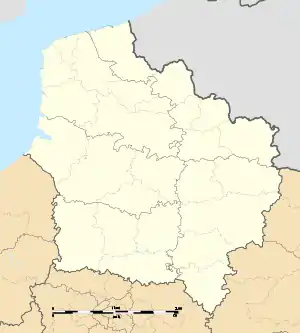Vieil-Hesdin
Vieil-Hesdin (Eng: Old-Hesdin) is a commune in the Pas-de-Calais department in the Hauts-de-France region of France.
Vieil-Hesdin | |
|---|---|
 The church of Vieil-Hesdin | |
Location of Vieil-Hesdin 
| |
 Vieil-Hesdin  Vieil-Hesdin | |
| Coordinates: 50°21′30″N 2°05′59″E | |
| Country | France |
| Region | Hauts-de-France |
| Department | Pas-de-Calais |
| Arrondissement | Montreuil |
| Canton | Auxi-le-Château |
| Intercommunality | CC Sept Vallées |
| Government | |
| • Mayor (2020–2026) | Christian Druelle |
| Area 1 | 9.82 km2 (3.79 sq mi) |
| Population (2017-01-01)[1] | 356 |
| • Density | 36/km2 (94/sq mi) |
| Time zone | UTC+01:00 (CET) |
| • Summer (DST) | UTC+02:00 (CEST) |
| INSEE/Postal code | 62850 /62770 |
| Elevation | 31–125 m (102–410 ft) (avg. 37 m or 121 ft) |
| 1 French Land Register data, which excludes lakes, ponds, glaciers > 1 km2 (0.386 sq mi or 247 acres) and river estuaries. | |
Geography
Vieil-Hesdin is situated 6 kilometres southeast of Hesdin, on the banks of the river Canche on the D 340 highway.
History
Once just simply known as Hesdin, this little village was, in the Middle Ages, a large and prosperous town. Its position in the heart of the county of Artois, once part of the Spanish Netherlands, led to its downfall. From 1471 until its destruction in 1553, it suffered many sieges and sackings, as a result of fighting between the Kings of France, the Holy Roman Empire, Henry VIII of England and several French nobles.
The end of Hesdin, as it was then known, was at the hands of Charles V. His 60,000 strong army had already ravaged Metz and razed Thérouanne in April 1553 and he ordered the city and the castle completely destroyed. A month later, the wreckers had finished their work. Only the convent and chapel were spared. Some months later, the demolition material was used to found a new city 6 kilometres downstream, at a village then called Maisnil. This new town took the name Hesdin-fert, then Hesdin-fort, eventually becoming Hesdin. The ruined town was known for a while as Hesdin-le-Châtel, then eventually as Vieil-Hesdin (Old-Hesdin).
Population
| Year | 1962 | 1968 | 1975 | 1982 | 1990 | 1999 | 2006 |
|---|---|---|---|---|---|---|---|
| Population | 338 | 338 | 371 | 362 | 364 | 364 | 382 |
| From the year 1962 on: No double counting—residents of multiple communes (e.g. students and military personnel) are counted only once. | |||||||
Places and monuments
- Château Estruval. A former convent of the Black Nuns. The façade, roof and cloisters are protected by decree of July 9, 1981. The garden walls and buildings (including two pigeon houses) are also protected by decree of April 28, 1993.